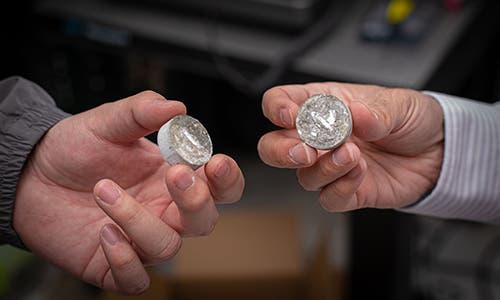
Using an enzyme normally found in red blood cells, researchers have designed a concrete mixture that can automatically seal cracks in the construction material by absorbing CO2 from the air and converting it to calcium carbonate crystals. The resulting concrete is almost four times more durable than traditional concrete, vastly extending the life of structures and slashing the huge upkeep costs required for repairs or replacements.
Concrete with a touch of enzymes
Concrete is the most ubiquitous construction material in the world. We use it to build everything from skyscrapers to sidewalks due to its durability and low cost. However, concrete is far from perfect, being prone to cracking due to continuous exposure to the elements. Humidity, sunlight, and stress from use slowly chip away at concrete. Over time, harmless microcracks can expand and lead to a loss of structural integrity. In the case of dams and bridges, concrete cracks could threaten the lives of countless people.
“If tiny cracks could automatically be repaired when they first start, they won’t turn into bigger problems that need repair or replacement. It sounds sci-fi, but it’s a real solution to a significant problem in the construction industry,” said Nima Rahbar, associate professor of civil and environmental engineering at Worcester Polytechnic Institute.
Rahbar is the lead author of a new study that took inspiration from nature to find a solution to this problem. The research centered around carbonic anhydrase (CA), an enzyme found in red blood cells that quickly transfers CO2 from the cells to the bloodstream.
The researchers simply added the enzyme to a conventional concrete powder before it was mixed with water and poured. These experiments showed that the enzyme acts as a catalyst, triggering a chemical reaction between atmospheric CO2 and molecules in the concrete to create calcium carbonate crystals.
Calcium carbonate is a common substance found in rocks such as the minerals calcite (a major component of limestone) and aragonite. It is also the main component of eggshells, snail shells, seashells, and pearls. Its atomic matrix is very similar to that of concrete, so when the calcium carbonate forms inside gaps in the concrete, the structural integrity of the material is preserved.
“We looked to nature to find what triggers the fastest CO2 transfer, and that’s the CA enzyme,” said Rahbar, who has been researching self-healing concrete for five years. “Since enzymes in our bodies react amazingly quickly, they can be used as an efficient mechanism to repair and strengthen concrete structures.”
According to Rahbar, the patented method described in the journal Applied Materials Today heals millimeter-scale cracks within 24 hours. You can see the process in action in the short clip below.
The mixture can also be applied to already-set traditional concrete to mend bigger cracks or holes.
The concrete industry is one of the most environmentally damaging in the world, accounting for 9% of total global CO2 emissions in 2018. Nearly 80% of concrete’s carbon emissions come from cement, which accounts for about 8% of the world’s carbon dioxide (CO2) emissions.
If the cement industry were a country, it would be the third-largest emitter in the world — not far behind China and the US. It contributes more CO2 than aviation fuel (2.5%) and is not far behind the global agriculture business (12%). But, overall, the construction industry, which includes not only the manufacturing of cement but also the transportation of heavy materials across the world, was responsible for a staggering 38% of all carbon emissions in 2019, according to the United Nations Environment Programme.
The enzyme-based mixture developed at the Worcester Polytechnic Institute extracts a negligible quantity of CO2. However, the mixture would offset a sizable amount of CO2 currently associated with the concrete industry by extending its life.
Rahbar makes a bold claim, predicting self-healing concrete could extend the life of a structure from 20 years, for example, to 80 years.


